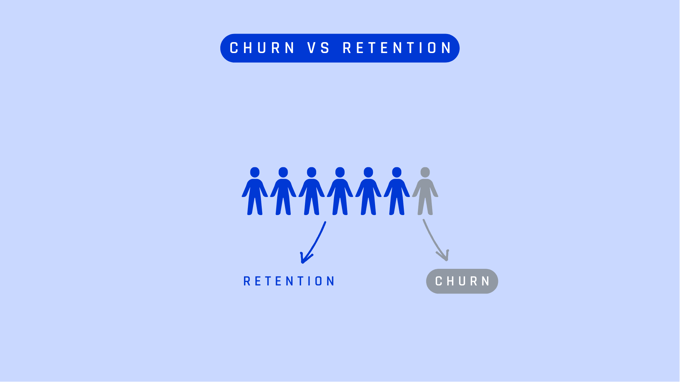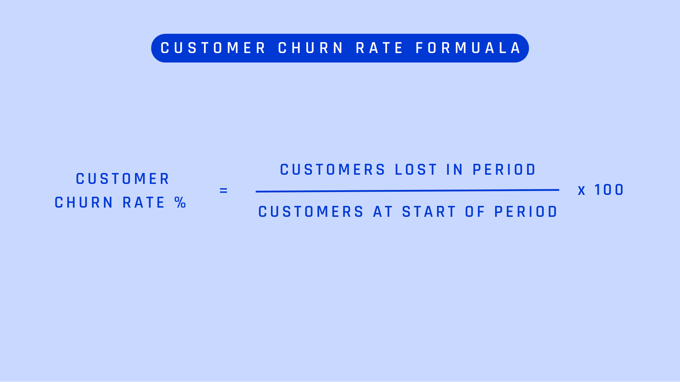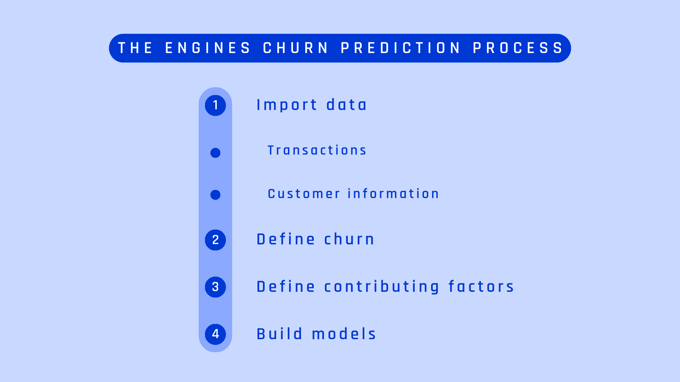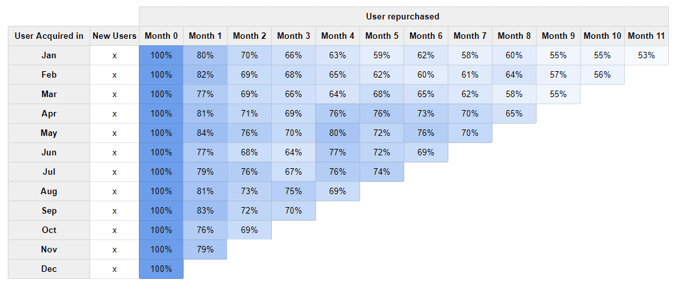A Guide to Customer Churn Analysis in 2023
Customer churn analysis is the process of finding trends in customer data in order to uncover who, when and why customers are leaving.
With the new release of a customer churn template on the AI & Analytics Engine, this article details a full guide on predicting and reducing customer churn.
Customer churn is probably the single most important metric to get right when it comes to business growth. I don't know if that’s an official record, but Guinness might as well make it one. It indicates if your customers are getting value from your product or service, and is the key driver of revenue and profitability. Customer churn and customer retention are opposite sides of the same coin. Put simply, churn = the proportion of customers leaving, retention = the proportion of customers staying. And the longer a customer is retained, the greater their lifetime value.
 Churn vs Retention
Churn vs Retention
The topic of churn is broad, and customer churn isn’t the only way of measuring churn in a business. Revenue churn measures recuring revenue, which takes into account customers spending less, and places a higher emphasis on the customers that are spending big. But for the sake of scope, I’m going to stick to customer churn for this article.
Customer churn happens to the best of businesses, there’s no way to ever stop it completely. In this article, we’ll explore how you can get that churn rate down, by predicting the customers most at risk of churning, why they're churning, and when. These are all the ingredients you need to proactively implement retention strategies, so you can keep your customers from jumping ship.
Customer churn rate is most commonly expressed as a monthly or annual percentage, depending on the natural frequency of purchase. In either case, the formula is:

Alternatively, you can also measure customer churn based on the cohort that they’re acquired. We’ll circle back to that a bit later.
This is a harder question to answer than it might appear. I hate to cop out with a vague answer - but it kind of depends, on a lot of things.
First of all, it depends on what you’re selling. This includes the natural purchase frequency and the price point. Secondly, it depends on who you’re selling to. The industry of your customers, and the type - Consumer, SMB or enterprise. There are enough variables to make your head spin, and make it really tough to say what your customer churn should be. I'd encourage you to read more on customer churn rate benchmarks.
Customer churn is bound to happen, but it pays to do everything in your power to reduce it as much as possible. That’s because it’s not just a business problem, that's a side effect, it's about understanding why a customer along the way somewhere isn't happy. That's a problem worth solving. And if you can get it right, it's not just the immediate revenue you stand to gain, it's the multiplier of delivering a better customer experience.
Before you start implementing any retention strategies or tactics, you need to know who you’re targeting - those that are at the most risk of churning. That's where you’ll get the most bang for your buck.
With the help of machine learning (ML), predicting customer churn has become more efficient and effective. ML can process large amounts of customer and transactional data to identify patterns and make predictions about future customer behaviour, such as their propensity to churn. From here, businesses can take proactive measures to prevent it.
Don't worry if you're not a data scientist or ML expert. The AI & Analytics Engine (the Engine) from PI.EXCHANGE is a no-code ML tool, that makes it easy to develop ML applications to solve just about anything.
We've doubled down on the easy, and have built a customer churn templated solution, purpose-built for marketers, growth, and customer success specialists. You only need to follow a 4-step process that asks simple questions, to get from data to predictions.
 The Engine’s 4-Step Churn Prediction Process
The Engine’s 4-Step Churn Prediction Process
The first step in the template is importing your customer information and transactional data by uploading or connecting to a database.
The next step is defining what churn means to your company because a customer can be considered churned under different conditions. For example, a customer churning might mean spending under a defined amount within a period of time, or not purchasing anything for a defined period of time.
Then the model is built and the data is analyzed using ML algorithms, determining which customers are exhibiting churn signals, and are likely to churn in the future. Marketers can use this knowledge to proactively target them with retention strategies.
Watch this video to see our Data Scientist, Dr. Kathy Sarafrazi, demonstrate how easy it is to use the churn prediction template.
The all-important why. You can use the “feature importance“ tool to get insight into the most influential factors on a customer's likelihood to churn. Perhaps your product or service has a much higher churn rate among certain age ranges, or once a certain period of time has passed after the first purchase. The Engine illuminates the insights within your data.
If you get the why, it means you understand the problem and can effectively implement a specific fix. If a customer is likely to churn because of their distance from your retail store, an in-store voucher probably won’t do much, but an online one might work. Or it might not. Just because you use ML to get an edge, doesn't mean you do away with the importance of feedback from your customers. To understand the nuances of their feedback, one-on-one communication works best, whether that’s by email, phone or social. If you don’t have the resources, you could try an exit survey.
Even though using the Engine to identify propensity to churn can give you clairvoyant-like foresight, it's still vital that you build an understanding of the common reasons customers churn. This helps you understand what to look for, and what to do.
When a customer purchases your product, they have a set of expectations about the benefits they’re going to achieve. The difference between their perceived benefits and perceived costs is known as perceived value. If they feel the benefits aren’t meeting their expectations, and are now outweighed by their costs, they are ripe to be swayed by a competitor.
Perceived costs might not just be monetary, it can also include time, effort, and psychological factors like risk and stress.
Churn in the early stage of the customer lifecycle can often be attributed to poor customer onboarding. This refers to all the customer touchpoints, both digital and physical, that go into shaping the new customer experience and preparing the customer to understand the value of your product or service.
Not getting this right would mean a user churning earlier in their customer lifecycle before they’ve realized the benefits of your product or service. This may show up in your data as few interactions or transactions associated with the product.
A bad customer communication experience can be disastrous, in fact, one in three consumers say they will walk away from a brand they love, after just one bad experience. When it comes to customer service, shortcomings in accuracy, friendliness, speed, and convenience can result in a once-loyal customer leaving.
If paid advertising is one of your main channels of customer acquisition, you might just be speaking to the wrong crowd. They might buy your product or service, but ultimately if it doesn’t fit their needs and wants, they’re not going to keep coming back.
Predicting who’s most likely to churn and understanding some underlying reasons why is only half of the equation. To start reducing churn, businesses need to take targeted actions addressing the root causes of customer attrition, in the form of a proactive retention strategy.
The first two steps in any customer retention strategy are setting up measurements to track progress and defining what success looks like by setting churn rate goals. Take a look at our guide on customer churn analysis to learn more.
Cohort analysis is a way of measuring churn that involves separating new customers from existing ones, and grouping them based on when they were acquired, and gives more granular detail into when in their lifecycle they’re churning.
Say, for example, you have an e-commerce business, and you sell a product that customers generally purchase monthly. By grouping customers who were first acquired in January into a cohort, you can track the proportion that return to make another purchase in February, March etc. The table may look something like this:
 Cohort-based retention analysis
Cohort-based retention analysis
Here we can visually see on a cohort-by-cohort basis, when in the lifecycle customers are churning by looking across the table, and the impacts of a retention strategy over time by looking down the table.
Now that you prepared yourself for measuring the effectiveness of your upcoming retention strategy, you can begin setting churn rate goals to strive for. A nuanced way of setting a churn rate goal is to divide your customer lifecycle into short, medium, and long-term timeframes (which can be clearly seen in the cohort analysis table), and have separate churn rate measurements and goals for each. For example, you may find out that your short-term churn rate is disproportionately high, and you may then hypothesize that prioritizing onboarding will yield the best results.
With all the preparation for the retention strategy done, it’s finally time to get into the specific tactics that will make the difference. Implementing customer retention tactics is an iterative process. Each tactic is an experiment, and each review will allow you to further optimize, or even reject it if it doesn’t work. With each iteration, you’ll gradually tend towards a better view of what works. Let's get into some.
First impressions count, and improving the new customer experience is one of the most sure-fire ways to reduce churn (especially early-stage). Even after the purchase, the new customer is still deciding on whether the product or service meets their needs, and the onboarding process is designed to help them understand the value they’re getting. A customer onboarding checklist may include:
An automated welcome email
A sequence of check-in emails, encouraging the use of a product or service
A video tutorial
An extensive knowledge base for FAQs
A good customer relationship breeds brand trust and loyal customers. Personalized communication is key, with 71% of consumers expecting companies to deliver personalized interactions, and 76% frustrated when it doesn't happen. There are heaps of tools to help make interactions more relevant for customers, from emails, chatbots, and even website content, so that your customers feel valued.
Regarding customer relationships, ensuring you have a channel to collect feedback and complaints through surveys or email forms is another way to improve your customer service. Accepting and appreciating feedback (combined with personalized communication), makes the customer feel heard, and that the company is actively improving the aspects they aren’t happy with. The added bonus is that it’s another way to gather valuable information to develop and iterate your retention strategy.
Price can be a reason why customers end up leaving, and sometimes it’s best to offer those customers special incentives to keep them from going to a competitor. However use caution, because if you cut into the margins too much, the customer may become unprofitable. In order to determine whether it makes sense for your business, you’ll have to analyze your customer lifetime value. Some examples of incentives include upgrades, discounted offers, and bundle deals.
It’s important to constantly remind customers how your product or service they’ve paid for is helping the achieve their goals or solving their problem, and is effective at reducing mid-late stage churn. This can be done by providing them examples of other customers success stories, demonstrating social proof.
Winning back lost customers should be obvious but is so easy to forget. Just because a customer has churned, doesn’t mean they’re gone forever. Setting up campaigns to target previous customers can be effective, especially when combined with your understanding of why they churned, so you can address their pain points.
Hopefully, this guide has helped your understanding of all things churn and you’ve learned something new. If you’re looking to level up your retention strategy, consider using the power of the AI & Analytics Engine to help target the right customers, and let us know how you go.
Not sure where to start with machine learning? Reach out to us with your business problem, and we’ll get in touch with how the Engine can help you specifically.
Customer churn analysis is the process of finding trends in customer data in order to uncover who, when and why customers are leaving.
A customer win-back strategy focuses on rectifying mistakes and generating goodwill, in order to regain lost customers, so they return to being...
AI isn't just for data scientists, tools that use AI can be used for many marketing tasks. In this article we'll go over the best AI tools for...